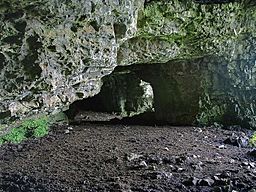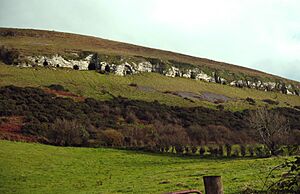Caves of Kesh facts for kids
Quick facts for kids Caves of Keshcorran |
|
|---|---|
| Keash Caves | |
 |
|
| Location | Keshcorran Hill, Co. Sligo |
| Geology | Carboniferous limestone |
| Entrances | 16 |
| Cave survey | R. L. Praeger (1901) |
The Caves of Kesh, also known as the Keash Caves or the Caves of Keshcorran, are a group of limestone caves found near the village of Keash in County Sligo, Ireland. These caves are located on the western side of Keshcorran Hill, which is part of the Bricklieve Mountains. There are sixteen simple rooms or chambers, and some of them connect to each other.
People have used these caves for thousands of years. It is thought that they were once important places for ancient gatherings or special events. Early digs in the 1900s found many animal bones. These included bones from brown bears, arctic lemmings, Irish elks, and grey wolfs.
Contents
Exploring the Caves: A Look Inside
The sixteen caves are made of white, cherty limestone. You can find them at the bottom of some low cliffs on the western side of the hill. They formed over time as rain and weather slowly wore away the carboniferous limestone. This type of rock is very common in the area. The caves go straight into the rock face.
You can find many Quartz crystals here. Also, large rocks left behind by glaciers can be seen at the entrance of some caves. This shows that Keshcorran Hill was once covered by a thick sheet of ice. The caves also show signs of being washed out by water. A layer of breccia (a rock made of broken pieces cemented together) is found in many of them. It is rare to find smooth, flat cave floors made of stalagmites. When they are present, animals like foxes and badgers often dig into them.
Discovering the Past: History of Exploration

The first detailed study of the Keshcorran caves happened in 1901. This exploration began after a piece of a bear's skull was found a few years earlier. Robert Francis Scharff, R. J. Ussher, and Robert Lloyd Praeger led these digs.
They found bones from many animals, including deer, ox, goat, pig, bear, horse, sheep, donkey, hare, mouse, rat, badger, fox, dog, wolf, and stoat. For the first time in Ireland, they also found proof of the Arctic lemming. This discovery made headlines across the country! Another important find was a reindeer bone, found above an area of burnt wood. This suggests that reindeer lived in Ireland until humans were present.
The explorers also found the four oldest types of molluscs (shellfish) known in Ireland at that time. They also recovered bones from several fish and many types of birds. These included the ptarmigan, smew, and little auk. Another interesting find was fossilized frog bones in the lowest layers. This showed that frogs were in Ireland much earlier than people used to think.
Finally, the excavations found signs that humans lived in the caves sometimes as far back as the Neolithic period (New Stone Age). More regular human activity was found from the 10th century onwards. Five human teeth and an arm bone (humerus) from a man were found. Man-made items included two bone needles, a bone comb, a stone celt (a type of axe), an iron saw, two bronze pins, and a stone axe. Shells from mussels and oysters were also found, which further supports that people lived there.
More explorations took place in 1929 and 1930. These digs found even more bones from lemmings, reindeer, mice, pigs, hares, horses, frogs, rabbits, sheep, foxes, stoats, bears, dogs, oxen, badgers, and rats. They also discovered bones from elk, cats, shrews, and ducks.
More recently, some of the animal bones from these digs were tested using radiocarbon dating. This method helps scientists find out how old something is. The tests confirmed that bones from the lower layers were from the late ice age. Bear, deer, hare, and wolf bones were dated to about 10,000 BC. Stoat bones were from around 6000 BC, and horse bones from about 400 BC.
The most recent discovery in the caves happened in 1971. A left shin bone (tibia) from an adult was found in a pool of water. It was later dated to the early 11th century. This matches an entry in the Annals of the Four Masters from 1007 AD. It says:
- "Muireadhach, a distinguished bishop, son of the brother of Ainmire Bocht, was suffocated in a cave, in Gaileanga of Corann."
Ancient Stories: Folklore and Mythology
The Kesh Caves are important in old Irish myths and stories. People continued to tell these tales by word of mouth until the 20th century. The caves are often seen as connected to the otherworld, a magical place. They were also thought of as places to be respected and even feared.
The story Cath Maige Mucrama tells that Cormac mac Airt, a famous king, was born at the foot of Keshcorran Hill. It is said that a wolf raised him in the caves, much like the Roman story of Romulus and Remus.
The caves also appear in three stories about Fionn mac Cumhaill, a legendary Irish warrior. In one tale, Fionn travels to a magical smithy (a place where metal is worked) inside the caves. Another story, Bruidhean Cheise Corainn, tells how the Tuatha Dé Danann (a group of magical beings) captured Fionn and tied him up in the caves. A third tale, the Death of Diarmuid in the Boar Hunt, mentions Diarmuid and Gráinne hiding in the caves from Fionn, who was angry with them.
A more recent story about the Keshcorran caves comes from a diary written in 1779 by Gabriel Beranger. He wrote:
- "This cavern is said to communicate with that in the county of Roscommon ... called the Hellmouth door of Ireland [at Rathcroghan], of which is told (and believed in both counties) that a woman in the county of Roscommon having an unruly calf could never get him home unless driving him by holding him by the tail; that one day he tried to escape and dragged the woman, against her will into the Hellmouth door ... and continued running until next morning. She came out at Kishcorren [sic], to her own amazement and that of the neighbouring people. We believed it rather than try it."
See also
 In Spanish: Cuevas de Kesh para niños
In Spanish: Cuevas de Kesh para niños


